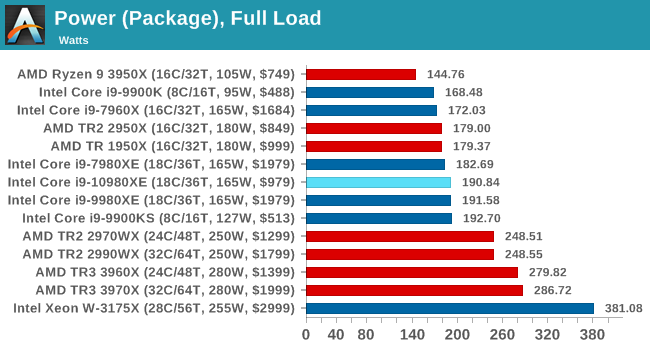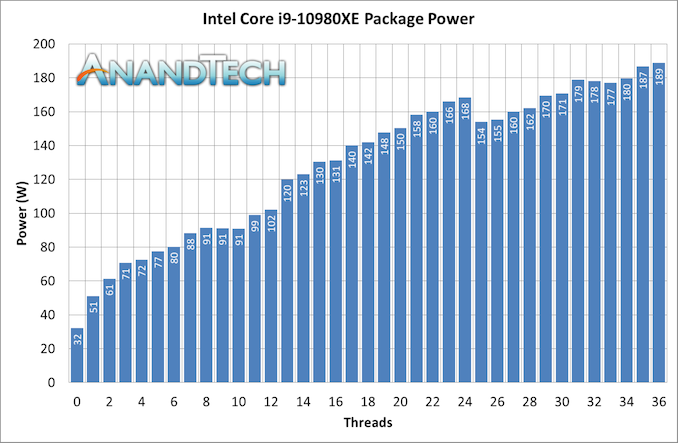It’s a Cascade of 14nm CPUs: AnandTech’s Intel Core i9-10980XE Review
by Dr. Ian Cutress on November 25, 2019 9:00 AM ESTPower Consumption
We’ve covered in detail across multiple articles the story of Intel’s turbo: about how the TDP on the box doesn’t mean a whole lot, the motherboard you’re using can ultimately determine how long your CPU does turbo for, and how the power limits of the processor are ultimately decided by the motherboard manufacturer’s settings in the BIOS unless you change them. Intel only gives recommendations on peak turbo power and the length of the turbo: the only thing Intel defines is the peak frequency based on load when turbo is allowed.
Talking Intel’s TDP and Turbo
Interviewing an Intel Fellow about TDP and Turbo
Comparing Turbo: AMD and Intel
This means that an extremely conservative system might not allow the power to go above TDP, but the system capable of all the power might allow the processor to turbo ad infinitum. The reality is usually somewhere in the middle, but for a high-end desktop platform, where most of the motherboards are engineered to withstand almost anything that comes at it, we’re going to often see the situation of an elongated or persistent turbo.
It’s worth noting that for consumer workloads, most of the work can happen within a reasonable turbo – and thus sustained performance metrics aren’t that important. But today we are testing high-end desktop hardware, and because Intel doesn’t explicitly define peak turbo power or turbo length (it only provides recommendations that motherboard manufacturers can and do ignore), I obviously asked Intel what it believes that reviewers should do when trying to compare performance. The answer wasn’t very helpful: test with a range of motherboards’.
In our previous review of the Core i9-9900KS, I did two sets of tests: benchmarks at the motherboard default, and tests at the Intel recommended turbo settings. The motherboard defaults, for that motherboard in question, were essentially full turbo all the time. Intel’s recommended settings gave some decreases in the long benchmarks, around 7%, but the rest of the tests were about the same.
For this review, we’re using ASRock’s X299 OC Formula motherboard. This is a motherboard designed for high-end and extreme overclocking, and is built accordingly. As a result, our sustained turbo and power limits are set very high. This is a HEDT system, and most HEDT motherboards are built and engineered this way, and so we expect our results here to be consummate with most users’ performance.
For our power consumption metrics, Intel actually does some obfuscation on its high-end platform. Unlike AMD, we cannot extract the per-core power numbers from the internal registers during a sustained workload. As a result, all we get are total package numbers, which show the cooling requirements of the processor but also include the power consumption of the DRAM controller, uncore, and PCIe root complexes.
The TDP of this chip is 165 W – normally Intel recommends a peak power of 1.25x, which would be 207 W, and so the 189 W value we see is under this. The chip we got is technically an engineering sample, not a retail part, although we usually expect the final stepping engineering samples to be identical to what is sold in the market. Despite this, your mileage may vary.
When we compare this peak to other CPUs:












79 Comments
View All Comments
wow&wow - Monday, November 25, 2019 - link
‘consumers don’t care about process nodes, so you shouldn’t either’The ex-CEO said, Intel processors function as intended, no bug, so using the design shortcut of partial addresses, causing many more security holes than AMD's, is intended, and enterprise and consumers don't care, so you shouldn’t either!
The more the security holes, the more the demand; what an amazing company and business!
nt300 - Tuesday, November 26, 2019 - link
Intel Processors even dating back to 2008+ all have massive amounts of security and malware vulnerabilities nightmare. Not only is ZEN superior technologically, its faster, securer and much more cost effective.HideOut - Monday, November 25, 2019 - link
You state that the AMD loses on PCI lanes but those PCI lanes are 4.0 vs 3.0. They are twice as fast per lane. With the right hardware the total bandwidth is the exact same.Thanny - Wednesday, November 27, 2019 - link
Which means nothing if you can't use your RAID controller or 10g network card because there aren't enough lanes to create the required expansion slots.I don't think there's a single X570 board capable of running a computer with a RAID controller or 10g network card, both of which require x8 slots. You could, in principle, bifurcate lanes to create more slots, but no one does that. So the fact that the lanes are PCIe 4.0 is utterly irrelevant.
If you want a non-toy computer, you need either Intel's -E/-X series processors, or, since 2017, AMD's Threadripper processors.
kc77 - Tuesday, November 26, 2019 - link
That summary makes no sense. The desktop AMD chip is beating the HEDT one with a $500 savings when you factor in motherboard cost. It's even beating it in gaming.If you picked up an older threadripper part for productivity it will walk all over the HEDT part and still be cheaper.
It doesn't matter what Intel does there's an AMD part available for cheaper.
Thanny - Wednesday, November 27, 2019 - link
TR 2000 is now cheaper, but its per-core performance lags behind Cascade Lake-X. It also has a higher-latency topology. If you want a real computer capable of running a RAID controller and 10g network card, for example, that also games reasonably well, and don't need really high core counts, then you'll get better results with Cascade Lake-X at the lower end.AMD has blundered. They should have released a 16-core Zen 2 chip, made it compatible with X399, and made it no more expensive than the MSRP of the 2950X.
kc77 - Wednesday, November 27, 2019 - link
If you're going HEDT you need the cores that's the whole point. Further more if you need ECC you won't get that with these HEDT parts while you will on all Ryzen CPUs from the bottom to the top.For HEDT ECC can be mandatory. If you want that with Intel you'll spend an extra $1000. Nope not joking.
Jimbo Jones - Friday, November 29, 2019 - link
"If you need HEDT but don't need cores ..."i7-7740x anyone? That CPU was laughed out of existence. Even the 8 core AMD TR died a quick death. That's how many people need a low core count HEDT processor.
peevee - Wednesday, November 27, 2019 - link
AMD NEEDS 20-core TR right under $1000 to fill the gap between $750 3950X and $1400 3650X and take the ground from under Intel's 18-core part. Unfortunately, they are almost out of numbers. 3955X? ;)They would benefit from a $800 16-core part too, perfect for those who are limited by PCI lanes or memory on 3950X.
Thanny - Wednesday, November 27, 2019 - link
As I see it, AMD is being daft by not releasing an X399-compatible 16-core Threadripper 3955X based on Zen 2.